Beetles
BEETLES - ALL
List of Beetles :
no common name
Anthocomus fasciatus
This is a tiny little beetle only 4mm long. It has to be seen in good light to appreciate that it has red markings.
Despite its size it is a predator and, when initially found on stinging nettles, had an even tinier fly in its mouth. The larvae of some Anthocomus species feed on the larvae of wood boring beetles and so may be found indoors.
Date
07.05.2004
Sighting
Indoor windowsill visitor.

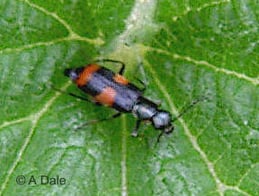
02.06.2005
On nettles by main gate to sheep paddock.
Cardinal Beetle
Pyrochroa serraticornis
Usually found on the edges of old woods where the larvae live under the bark of decaying timber, this one was found on an old hawthorn and blackthorn hedge, where there would be no shortage of brash in the hedge bottom. About 15mm long.
A related species, P. coccinea, slightly larger and identified by a black head, is also found in the UK but tends to favour a habitat deeper in the wooded area.
Date
27.06.2004
Sighting
Hay meadow eastern hedge by southern gate.
08.06.2005
Hay meadow western hedge on cleavers.
28.05.2012
Two seen on ditch side Cleavers and Garlic Mustard.
The small detail image better shows the heavily toothed antennae which are a striking feature of this species.
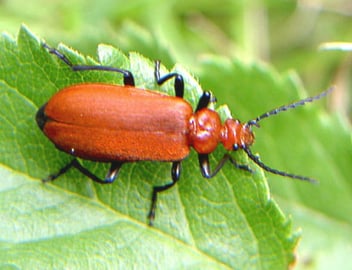

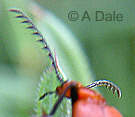

Found in decaying wood chips under old Chestnut tree.
24.05.2007
Carpet or Museum Beetle
Anthrenus verbasci
Anthrenus verbasci is a slow moving, small beetle, no more than 4mm long. Unless seen in good light, it's body markings can be quite indistinct and it really needs a lens to see them clearly. It is a member of the Dermestidae family of beetles, some 30 of which are to be found in the UK and many are considered to be household pests.
Despite it's common names of Carpet or Museum Beetle the adults feed on pollen and all the adults that I have come across have been found on white external window ledges or indoor window sills. While this would seem to testify to their ability to fly, it also poses the question of how many escaped my attention wandering over dark surfaces.
Date
26.05.2009
Sighting
Adult beetle found on an outdoor window ledge.
08.06.2010
Adult beetle found on an indoor window sill.
28.05.2012
Larva found on same indoor window sill as the adult above.
It is the 3 - 4mm long larvae of the species that have earned a bad reputation by feeding on keratin and chetin. A very good image of a well fed larva is to be seen here.
Keratin is a constituent of hair, fibre and woolen textiles - commonly found in carpets and clothing. The larvae are small, slow moving, hairy, and dark in colour and so are easily overlooked. It is only when damage has been done that attention is focussed on them.
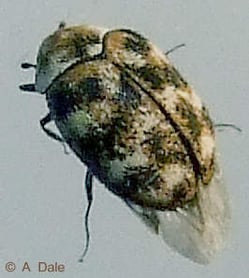



Adult beetle found on an indoor window sill.
19.11.2010
Chetin, on the otherhand, is found in dead skin, nails and claws and this is what attracts the beetles to museum collections. Such collections are usually static and are often housed in drawers and cabinets so that damage usually goes un-noticed over time until the exhibits start falling apart.
Given that the adults are capable of distributing eggs over a wide area and that the larvae are difficult to see means that once they become well established they can be quite difficult to eradicate.
A carrion beetle
Necrodes littoralis
At first glance there is a possibility of confusing this beetle with the all black Nicrophorus humator which is the same size, 18 to 22mm. However, in N. littoralis, the antennae are straight, not club shaped, the ridges on the wing cases are better defined and there are prominent 'bumps' on the wing cases that, in human terms, could be referred to as shoulder blades and hip bones.
Date
05.08.2011
Sighting
Attracted to lighted window.

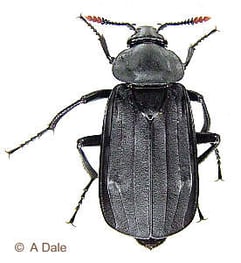
The image of the head better illustrates the straight antennae and also highlights the eyes which are rather large by normal beetle standards.
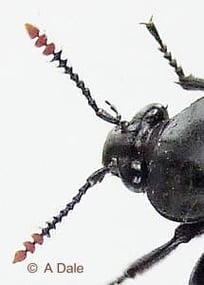

Whereas the Sexton beetles bury their small prey before devouring them, N.littoralis is to be found on the larger exposed carcases of rabbits, game birds, etc.
The latin descriptive name, 'littoralis', implies that this is a coastal species and while it can be found in the debris of the tidal strand line, it is just as likely to be seen well inland. Indeed it has been recorded in Central Europe.
Click beetle .... aka Red-brown Skipjack
Athous haemorrhoidalis
The 'Click beetle' family comprises more than 7,000 different species. The one shown here is one of the more common British species. Their usual mode of defence is simply to fall to the ground. Should they land on their backs they have the ability to flip themselves upwards with a sharp clicking sound - and hopefully land right way up. Hence the common name of 'Skip-jack'.
The adults, this one was 13mm long, are to be found from May to August and are omnivorous, taking both small insects and a vegetarian diet. The larvae are strictly vegetarian.
Date
15.05.2005
Sighting
Found on fence post in N. Paddock.
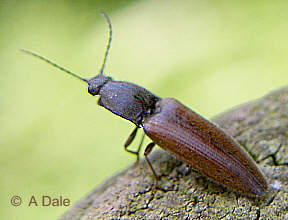

24.05.2007
Three seen on vegetation close to 2005 sighting in N. Paddock.
02.06.2012
One found on roadside verge nettles.
The larvae of the smaller, all brown click beetles, Agriotes lineatus and A. obscurus are well known to gardeners as wireworms, capable of causing severe damage to plant roots.
a 'Click beetle'
Agriotes obscurus
- probably. The photograph leaves something to be desired. But as I moved in for a closer shot, this click beetle did what click beetles do best, it tucked its legs up and fell off the leaf, never to be seen again. I should have been warned - it's antennae are already folded back in stage 1 of it's 'feign dead' defense tactics.
There are over 150 different species of click beetles to be found in Europe - 69 are found in the UK. At about 10 mm long, Agriotes obscurus is one of the more common. A similar species, Agriotes lineatus shares the same geographic distribution and arable habitat but is lighter brown.
Date
24.05.2005
Sighting
On white dead nettle opposite front door.

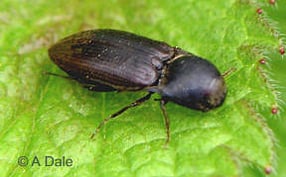
Click beetle larvae are the notorious thin yellow 'wireworms' which are the bane of gardeners lives as their vegetarian diet plays havoc with the root systems of vegetable crops, grasses and other plants.
a 'darkling beetle'
Lagria hirta
The 'common name' is a generic term covering a multitude of species, some 15,000 worldwide.
From the various images that I have seen, there appears to be a slim form (as in the image on the right) which I presume to be the male, and a slightly more rounded form which may well be the female. But, I have yet to see that clarified.
Date
Sighting
First seen, but not identified, on Hedge woundwort.
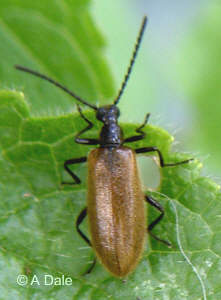

26.07.2004
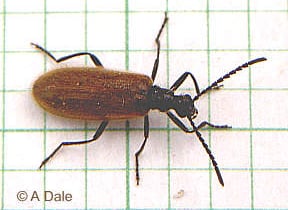

This 8mm beetle has a covering of short hair over its elytra (wingcases) and to a lesser extent over the thorax and head. It is common throughout the UK.
The larval stage survives from late summer through to spring in damp leaf litter. If the environmental conditions are optimal and the mature final instar stage is able to pupate without delay, research has shown that this results in bigger (up to 10mm long), more fertile adults.
17.07.2005
Flew in through back door at night, attracted to light - and was identified!
21.07.2005
Four sitting on a windwsill attracted to light.
21.07.2005
One on a windwsill attracted to light.
no common name
Demetrias articapillus
When I first saw this, I honestly did not know what it was. It was the wrong season for flying ants and yet it didn't look right for a fly. Only when the photograph was enlarged did I realise that the visible wing should have been tucked away and that it was a beetle.
It turned out that it was Demetrias articapillus, a 6mm member of the 'Ground Beetle' family. It is very common in Eastern and Southern England, confined to coastal lowland Wales and, apparently, not found in Scotland at all. Being an aphid eater it is regarded as a farmer's friend.
Date
10.05.2009
Sighting
Found on top of a garden waste bin.
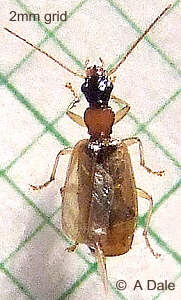

Although it was found in bright daylight it was very active in its attempts to hide and proved difficult to photograph. But one can see that the left elytra, displaced by the un-retracted wing, is almost transparent and does not cover the full length of the abdomen - and that is a trait of the Lebiini tribe of the Carabidae family. In sunshine the elytra appeared to be golden.
Dor beetle
Geotrupes stercorarius
This is another of the cumbersome looking beetles which, lacking any semblance of aerodynamics, still manages to fly quite successfully. The one shown upper right was rescued from a water trough, allowed to dry off for 20 minutes and then, wing cases opened and off it flew with a low rasping droning buzz ('dor' was an old word for 'drone') that could be heard up to ten metres away.
Date
10.08.2005
Sighting
Rescued from water trough in sheep pasture.


The beetles normally frequent grazing pastures - where they dig out a nesting tunnel under suitable dung and line the nest with dung for the larvae to feed on. But they are also found in woodland where they use decaying fungi or rotting plants as a breeding habitat.
Although apparently plain black, they have a blue or green sheen that shows up better in real life and is best suggested in the middle image.
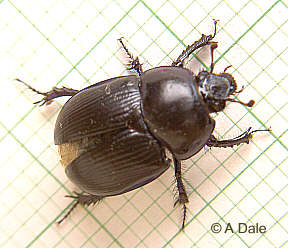

10.11.2007
Large 26mm specimen found, crushed, on the patio.
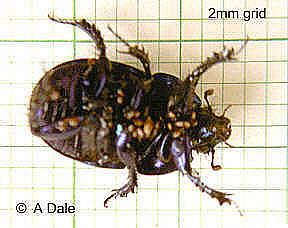

Coincidentally, the beetle in the second image was also rescued from a water trough, which suggests that their flying ability is rather better than their landing technique. This image shows how the wing cases or elytra (modified forewings) hinge forward to allow the wings to unfold to twice the elytra length when fully extended.
The lower image reveals the mites that these beetles carry around with them - which earns them the name of 'Lousy Watchman'.
This species is identified from similar species by the small 'dimples' on the outer edges of the pronotum (just visible in the upper images). The adult beetles, 16 - 26mm, are classed as fairly common in the UK and are to be found from April to October.
17.08.2008
Another 26mm specimen found in a water bucket by a sheep paddock.
a Flea beetle
Longitarsus sp.
This is a tiny little beetle - only about 3mm long, but the distinctive way that it's hind leg femurs stick out make it look just a bit different. And it is these hind femurs that are responsible for it's common name, 'Flea Beetle'. When the beetle is disturbed, they are able to propel the beetle in a huge 'flea like' jump. Definitely a case of 'now you see it, now you don't.'
Date
Sighting
Found in warm sunshine on a white painted exterior wall.
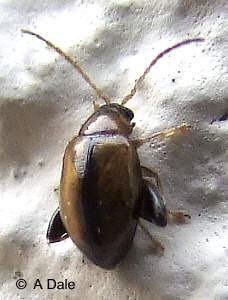

16.03.2009
There are some 40 different UK Longitarsus species and definitive identification requires microscopic examination so, this one remains anonymous.
Both larvae and adults are vegetarian and different species are found on a wide range of different food plants. But, this one was found on a white painted wall that was no help at all in identifying it.
'a thick legged Flower beetle'
Ischnomera cyanea
Both the images seen here are of female beetles which hardly live up to the 'Thick legged beetle' common name. However, there is an excellent image of a male beetle here that illustrates the exaggerated hind leg thighs (femora) that amply justify the common name.
Date
Sighting
Found on Salix caprea pendula.
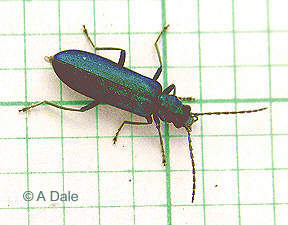

22.05.2005
Two specimens were found within days of each other. One, at rest, sunning itself four feet up on a Salix caprea willow and the other at rest, at ground level on buttercup foliage. But, when disturbed, both proved to be quite active, indulging in many short sharp flights.
This is one of only nine species of the Oedemeridae family to be found in the UK. As confirmed by the scale, it was 9mm long.
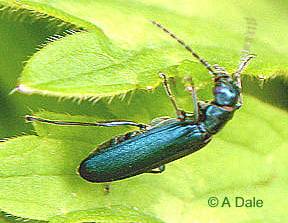

24.05.2005
Found on buttercup foliage.
In bright sunlight, this beetle is a brilliantly coloured iridescent cyan blue (the lower image hardly does it justice) but, in different lighting conditions, it can appear to be brilliant iridescent green. Quite spectacular. I have seen it referred to both as a 'blue beetle' and as a 'green beetle'. The upper image hints at the colour variation which depends on lighting conditions.
The larvae live in soft decaying wood.
Ground beetle
Abax parallelepipedus
There are some 300 plus species of ground beetle in the UK. Of these, 30 plus are all black. But, this is one of the larger ones, measuring up to 22mm (just under an inch) 'nose to tail' discounting palps and antennae so, that narrows the field down quite a bit.
To distinguish this one from the very similar Pterostichus niger, one has to take a close look at the elytra wing cases. P. niger has two pores on each elytra whereas this one has none. Which is all very well if you can get your beetle to sit still long enough to have a really close look at it. But, as the common name suggests, they live in the ground litter and try very hard to get back under protective cover as quickly as possible.
Date
Sighting
Late night indoors visitor.
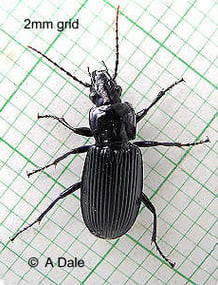

28.04.2004
They are preyed upon by all manner of larger vertebrates - rodents, hedgehogs, foxes and badgers, as well as birds. Although some Ground Beetles are vegetarian, many (including this one) are well equiped with a serious pair of jaws and will feed on a wide range of insects, grubs and caterpillars.
Beetle larvae are not well documented.
08.07.2007
Common in grass and ground litter.
18.11.2007
22mm specimen in good condition found in damp leaf litter.
cereal Leaf beetle
Oulema melanopa
At only 5mm in length this cereal leaf beetle could hardly be called conspicuous, but a close inspection shows it to be very handsomely coloured.
Both the larvae, which appear like very small slugs in early summer, and the adult beetles feed on grasses and are considered to be a pest of cereal crops. By eating the surface of the leaves they diminish the vigour of the food plant and thus it's productivity.
Date
Sighting
4.5mm specimen found on dead grass stalks by hay Meadow eastern hedge.

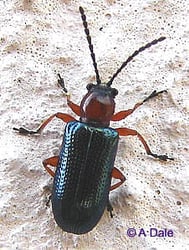
15.03.2006
The species is reputed to be abundant from April to September. When the food plant dies back, the new adults take refuge in loose litter at ground level where they shelter till the following spring.
24.04.2006
5mm specimen found on garage wall.
18.03.2009
4.5mm specimen found on garage wall.
Willow Leaf beetle
Galerucella lineola
......... or Lochmaea caprea ?
This is a case where one 'common name' can relate to more than one specific species. Although Galerucella lineola and Lochmaea caprea can be uniquely identified under a microscope, they appear to be superficially very similar. That both can be found on the same host plant (Salix caprea) only adds to the dilemma.
Date
Sighting
19.05.2004
Several groups of eggs found on same tree.
26.05.2004
Several beetles found on Salix caprea.
What could confuse expert opinion even more is that the images alongside are of different specimens so both species may well be represented. The beetles are only about 7mm long.
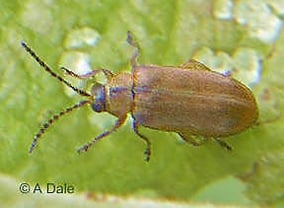


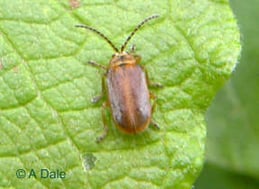
The group of eggs shown are typical of the Willow Leaf Beetle and several groups were found. The curious thing is that of the three groups I photographed, all contained 18 eggs - maybe just coincidence.
The eggs hatch into small black larvae which then develop into small stocky green caterpillars with black spots and a series of short black lateral bars down the length of the body.
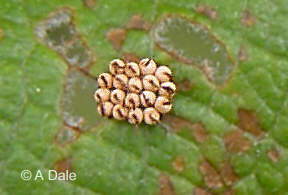

Both larvae and beetles eat the willow leaves and, small though they may be, an infestation can wreak considerable damage to the tree foliage.
Lily beetle
Liliocerus lilii
It may only be 8mm long but, with its vivid red colouring, the Lily Beetle is really hard to miss. In my garden, it usually appears first feeding on the seed heads of the spring flowering Snakeshead Fritillary, Fritallaria meleagris, before moving to the later maturing oriental garden lilliums.
Date
Sighting
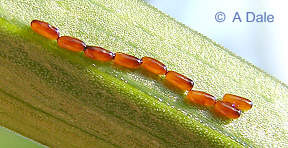

01.06.2007
Beetles found on Snakeshead Fritillary seedheads.
26.06.2007
Larvae grazing on lillium leaves and a further batches of eggs found.
05.05.2008
Two beetles found on Snakeshead Fritillary although seedheads not yet matured.
20.05.2010
First adult sighting of the year on Snakeshead Fritillary seedheads.
08.05.2012
First adult sighting of the year on Snakeshead Fritillary.
It is on the underside of the lily leaves that it lays its scarlet eggs (second image) in batches of up to 12 or so. These tend to darken as they mature and are almost black before hatching.
The tiny larvae commence grazing the surface of the leaves as soon as they emerge from the eggs. So, leaf damage is often seen surrounding empty egg cases. Eventually they will move to the choicer flower heads and it is the disfiguring damage that they cause there that earns them the wrath of keen gardeners.
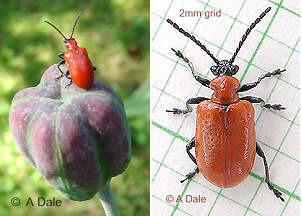


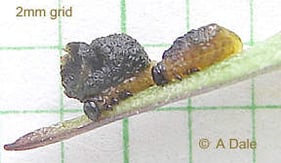
It has to be said in their defence that the larvae are very environmentally conscious. They scrupulously gather up their own excreta and carry it around on their backs.
"Now, how do they do that?"
I'm glad you asked that.
They lie on their sides and gently back into and under their 'waste product' and nudge it into place. Yes, I know it is sad but I've watched them do it!
Longhorn beetle sp.
Stenocorus meridianus
No common name for this beetle. It is just one of the 60 or so members of the British Longhorn beetle family (Cerambycidae). It is to be found around the fringes of wooded areas since the larvae develop in the damaged timber of diseased deciduous trees and the adult beetles frequent flowers and shrubs in the months of May and June.
Date
19.06.2003
Sighting
Protected Roadside Verge.


Colouration can vary from a uniform dull yellow through to almost black and it can range from 15mm to 25mm in length.
Longhorn beetle sp.
Leptura maculatus
Again, no common name for this Longhorn beetle. But this one does enjoy the not uncommon privilege of an alternative latin name, having been previously placed in the 'Strangalia' genera. This is perhaps the most common of the British Longhorns.
It is to be found around the fringes of wooded areas since the larvae develop in the damaged timber of diseased deciduous trees - and occasionally spruce, and the adult beetles frequent flowers and shrubs from May through to August.
Date
28.06.2003
Sighting
Little Scrubbs Meadow.
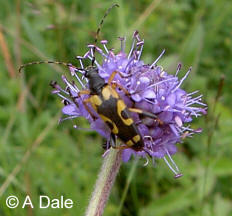

The yellow markings can be very variable, from almost completely yellow through to almost completely black. It ranges in length from 14mm to 20mm.
Common Malachite beetle
Malachius bipustulatus
Malachius bipustulatus is a small soft bodied beetle covered in short sparse hair. It is only 5 to 8mm in length but, those two red spots at the ends of its elytra (wing cases) are enough to attract ones attention. And, if one looks closely, it sports tufts of buff hair on its face. The small buff projections at the base of the antennae indicate that this image is of a male.
The adult beetle is found from April to July mainly on vegetation, where it feeds on the pollen of grasses and flowers but, later in its season, is also found on trees where it lays its eggs in cracks in the bark.
Date
27.06.2004
Sighting
Found on dead bark at foot of old Chestnut tree.
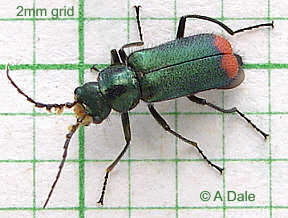

The image of the larva is of a mature larva in a pre-pupal state, darker than normal and beginning to 'bulk up'. The little marks on its back just behind the head are characteristic and much more prominent in younger, paler larvae.
This one was found under a small pile of fresh granulated 'frass', the residue of its tunnelling activity under dead bark. The larvae are predacious on smaller insects living under the loose bark of trees. A very good image is to be found here.
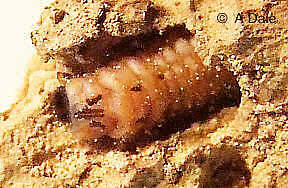

26.05.2007
Found on foliage by drainage ditch.
13.04.2012
Larva found, about to pupate, under pile of 'frass' on a dead Chestnut tree.
03.05.2012
Adult beetle emerged from the pupated larva.
There are five other members of the genus found in the UK but M. bipustulatus is the most common and is to be found throughout the length and breadth of the country.
'Rove beetle'
Philonthus politus ?
Rove beetles are usually all slim beetles with small wing cases but, they come in all sizes, from the Devil's Coach-horse at 30mm, down to several at only 5mm. There are many genera - and even within the Philonthus genus there are many species. So, positively identifying them is something of a lottery. I think this one at 14mm long, is P. politus but, I wouldn't swear to it.
Date
Sighting
Found at mid-day on garage wall.

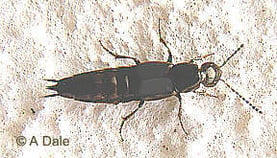
09.08.2005
They are scavengers and carnivorous, often found around decaying plant and animal matter.
Despite having small elytra (wing cases), their long wings can be very quickly extended and they take flight surprisingly quickly. It is only when they are about to tuck their wings away again that one can see that the wings actually stretch all the way to the end of the abdomen.
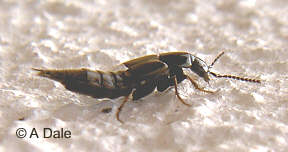

Many Rove beetles raise the end of their abdomen when disturbed (the Devil's Coach-horse being a classic example), and the lower image shows that reaction. This characteristic earns them the name of 'cock tail' beetles. They are reputed to squirt a strong smelling vapour into the faces of their predators.
A Rove beetle
Ocypus winkleri (pos)
When this wandered across the kitchen floor, my first impression was that it was the 'Devil's Coach-horse', Ocypus olens. But, apart from general similarities, it was obvious that it was not big enough or robust enough for that. While Ocypus olens can be 32mm long, this was only 20mm when active and 17mm at rest.
It belongs to a group of very similar species (the Ocypus globulifer group) that can only be positively identified by microscopic examination. Of that group O. winkleri is the most common in the UK and therefore the most likely candidate.
Date
Sighting
Found indoors late at night.

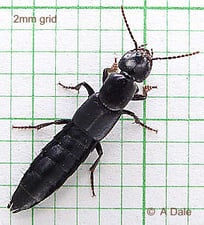
26.10.2007
They live in cool damp places at ground level - usually in garden or woodland habitats, hiding under fallen wood or stones by day and feeding on small insects and grubs.
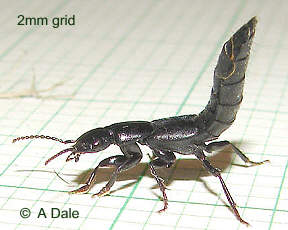

Whereas the abdomen of most beetles is covered by smooth wing cases (elytra), the greater part of the rove beetles abdomen, which is covered by short bristly hairs, is exposed behind very short elytra that never-the-less cover fully functioning wings which make them proficient fliers. The wing folding process after flight is interesting to watch, if you get the chance.
To a greater or lesser degree, all the rove beetles adopt a 'scorpion like' posture when alarmed. They stand their ground, raise the rear abdomen up and forwards and open their jaws in a threatening display. If provoked enough, they will actually bite - which is usually enough for most humans to 'back off' although the damage is likely to be only superficial.
a Rove beetle
Coprophilus striatulus
This, like the previous species, is another member of the huge Staphilinidae family of Rove beetles, of which some 900 species are found in the UK. They range in size from 2mm to 32mm. This one was 6mm in length and is the only Coprophilus species to be found in the UK.
Date
Sighting
Found in warm sunshine on a white painted exterior wall.
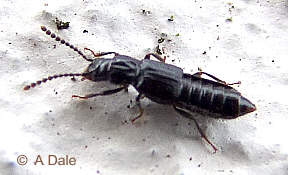

16.03.2009
Although the Coprophilus genera name implies that it feeds on dung, it is commonly found around compost heaps and decaying vegetation. The adult beetle is normally only seen during the springtime breeding season. Beetle larvae are invariably small white grubs and are notoriously difficult to identify.
Sexton beetle (1)
Nicrophorus vespilloides
Several beetles are known as Sexton, burying or grave digging beetles for their habit of carrying off the dead. These are carrion eaters and are usually to be found around - or in (!), the corpses of dead animals and birds. The bodies of small creatures are buried by the beetles excavating a hollow under the corpse and dragging it underground. They then lay their eggs by the body which will provide the food source for the emerging larvae.
Despite their gory life style the beetles are good mothers. They stay with the newly hatched grubs, feeding them partially digested food and biting holes in the carcase to allow the grubs to enter it and fend for themselves.
Date
30.07.1999
Sighting
Willingham Woods.
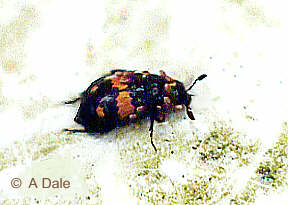

This particular species is only about 16mm long although other Nicrophorus species can reach 30mm in length. The image shows that the beetle can carry a group of mites which will be transported from one food source to another.
Incidentally, the original name for the genus is thought to have been 'Necrophorus' (from necro; a dead body), but somewhere along the line, an early scribe mis-spelled it and the 'nicro' prefix has been perpetuated.
A fascinating insight into the lifestyle and development of the genus is to be found 'here' . The translation from the original German text gives it added character. If the full text seems daunting, there is a very succinct summary at the end of the piece.
Sexton beetle (2)
Nicrophorus investigator
This Sexton, at 26mm, is somewhat larger than N. vespilloides (above) and has dark reddish tips to its antennae. Other identifying features include the absence of hairs on the thorax and straight tibias on the hind legs. Live specimens show three abdominal segments protruding beyond the elytra. But, sometimes, if a dead beetle is found, caught up in a spiders web, for instance, this feature may not be evident resulting in a rather truncated appearance.
A very similar, but much rarer species in Lincs, N. interruptus has a wider gap between the forward elytral marks and has yellow hairs on its protruding abdominal segments.
Date
28.07.2004
Sighting
Attracted by light at night.

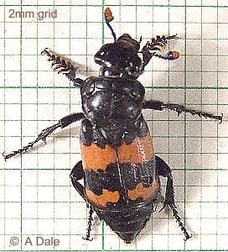
The Sextons are strong fliers but lack manoeuvrability and landing skills. Consequently they often bump into things and their landings are usually less than graceful. Their flight is quite noisy and the clatter they make, banging into windows, doors and lampshades, is enough to make one duck to keep out of their way.

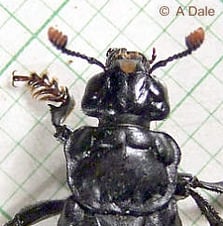
The lower image details the red tipped antennae and the elaborate feathering on the front legs that is used to rake away soil as they excavate tunnels to their underground breeding chamber.
All the sexton beetles may be found to be carrying quite a colony of red mites. I have watched beetles trying to wipe the mites off but, it has been established that the beetles and mites live in a symbiotic (mutually co-operative) relationship. So, rather than appearing as irritating parasites, the mites are only 'hitching a ride' to the next carcase where they will feed on mould that may grow on the decaying carcase thus keeping the carcase 'fresh' for the beetle larvae to feed on.
A fascinating insight into the lifestyle and development of the genus is to be found 'here' . The translation from the original German text gives it added character. If the full text seems daunting, there is a very succinct summary at the end of the piece.
They are scavengers, living off and breeding in rotten carcases. They have a very good sense of smell and are reputed to be able to smell a carcase up to two miles away - although, in the harsh natural world, I would be surprised if the nearest corpse would be that far away.
Whether it is due to their preferred environment or whether it is a natural defence reaction, they can emit a foul odour which is sufficient to make most humans recoil. So close inspection is only for the brave hearted.
24.08.2009
24.09.2009
Attracted by light at night.
Attracted by light at night.
Sexton beetle (3)
Nicrophorus humator
All the burying beetles (or Sexton beetles) belong to the family Silphidae. This one (at 18 to 27mm) is likely to be the largest found in the UK. There are other all black species, but this one is identified by its orange 'toothbrush-like' antennae, and orange hairs around its mouth, forelegs and the end of its abdomen.
They feed and breed on carrion, and while flying towards the scent of the next meal, are often attracted to light - which accounts for most sightings of them. Otherwise, the surest way to find them is to inspect (!) the corpses of small animals or birds.
Date
Sept. 1999
Sighting
Found in Willingham Woods on a dead Pheasant. Took three very good pictures of where it had once been!


The adults are active during the spring and summer months. Being large and cumbersome, the act of flying must be tiring and on landing, often a crash landing, their movement can be quite slow and deliberate (good time for observation). But, once they get their breath back, they are well able so scamper off at a fair pace.


The lower image shows just how far the extended wings protrude beyond the elytra (adapted wings forming hard protective wing cases that pivot upwards in flight). Also note that, in this dead specimen (found in a spiders web), the terminal abdominal segments have shrivelled out of sight.
A description of the Nicrophorus lifestyle is to be found here. The translation from the original German text gives it added character. If the full text seems daunting, there is a very succinct summary at the end of the piece.
31.07.2004
08.08.2007
Dead specimen found with wings still extended.
Six found on a decomposing rabbit carcase on road-side verge.
24.03.2010
One 26mm beetle found near a rubbish bin at night.
One 26mm beetle found near a rubbish bin at night.
21.04.2013
Sexton beetle (4)
Nicrophorus vespillo
This is one of several Sexton Beetles (grave diggers) that look superficially similar with signature red and black markings. They are all scavengers and breed on or in carrion. They tend to select small dead mammals and birds which they bury, to protect their breeding site, by excavating the soil beneath the carcase. Selecting bigger carcases would leave the beetles vulnerable to larger scavengers like crows, magpies, foxes, etc. - unless the carcase is already buried in dense litter or had sought refuge in a hole or burrow.
Date
29.08.2008
Sighting
Found adjacent to the nest of a Field Vole with young.


Unfortunately, some of the species identification features are not always as obvious as are sometimes stated. For instance, the hairy elytra and abdomen may not be as prominent as seen here and the tibia of the hind legs are often quoted as being significantly curved - but not in this specimen. And the little 'furry' pads just behind the head are not all that easy to spot in an active specimen. The tips of the antennae are, however, consistently orange. N. vepillo can also vary in size from 12mm to 22mm.
A description of the Nicrophorus lifestyle is to be found in a classic paper at this link. The translation from the original German text gives it added character. If the full text seems daunting, there is a very succinct summary at the end of the piece.
no common name
Silpha atrata
Although this beetle is classed as common, it is not seen frquently since it hides away during daylight hours in loose soil, leaf litter, or under logs or stones in damp places. At night it comes out to forage for snails principally but, it will also take slugs, worms and soft bodied larvae.
Date
07.06.2007
Sighting
Found (out of season!) under a damp piece of bark in a field drainage ditch.


This beetle is only 10 to 15mm long and normally found in the cool damp habitats favoured by snails. The beetles are inactive in cold winter conditions and rarely seen during hot dry summer months.


It's head is noticeably smaller and narrower than other members of the Silphidae family such as the Nicrophorus specie and it also has an extendable neck. This allows it to penetrate quite deeply inside a snail's shell where it releases an immobilising fluid that also helps to breakdown and soften the victims body. When threatened, the flexible neck allows the head to withdraw back underneath the protection of the thorax plate.
Lesser Stag beetle
Dorcus parallelipipedus
These beetles live in the rotten wood of deciduous trees, mainly beech, elm and ash - and there is no shortage of ash in these parts. They are mainly nocturnal and not often seen in the open, but this one was found on the patio, in a plant tub tray, early one morning having, presumably, misjudged its night time flight path.
It would appear to be limited in distribution to the southern half of England but can be locally common. This specimen was 21mm long (it seemed bigger!) but some males can be up to 32mm in length.
Date
30.07.1999
Sighting


The larvae may spend three or four years within dead timber eating the rotten wood. On maturity they pupate within the timber and emerge as the adult beetle in Spring or Summer with only reproduction in mind. The adults live only a few weeks and do not feed but survive on water and plant juices.
12.07.2005
Back garden.
Found marooned in a plant pot tray on the back garden patio.
Other beetles, the Ground beetle for one, can be quite lively and will scamper about at speed. But this species is really lethargic on the ground (and quite clumsy in the air) and this specimen allowed itself to be posed for the photo shoot with no difficulty. It was released back to a rotten tree stump from where it could have a second attempt at a night flight to find itself a mate.
Thistle Tortoise beetle
Cassida rubiginosa
My attention to this species was attracted by the damage to the leaves of Creeping Thistle, Cirsium arvense. This led to the finding of the larvae which graze irregular shaped patches of the upper surface of the thistle leaves - and then to the discovery that the larvae adopt a similar habit to the Lily Beetle larvae in that they carry their excreta around on their backs. In common with many insect larvae, they have twin slim appendages (cerci) at the tip of the abdomen and in this species they are used to hold the accumulated waste on the upwards curving abdomen. The cerci can be seen clearly in the third image.
Date
30.07.2007
Sighting
Thirteen larvae found on two clumps of Creeping Thistle.


After some three weeks or so, the transformed adult emerges from the pupa, and the jet black body can easily be seen through a pale quite transparent thorax. Within 24 hours it starts to colour up but it takes nearly another ten days to take on its final opaque adult colouring.


09.08.2007
Two larvae entered pupation.


Prior to pupation, the waste is shed and the larvae start their metamorphosis with a motionless diapause period of a day or so. The outer skin then splits to reveal the emerging pupa but appears to abort, or so I thought, when only half way out of the larval skin (see third image). It was only after I had seen this happen three times that I realised it was normal for the species.
The 7mm long adult is quite slow moving, often motionless. It has the ability to pull in its antennae and legs and closely hug the leaf surface like a large 'scale insect'. Against green leaves, it can be remarkably difficult to spot - even when one knows that it is there!
This species can be identified from its close relative, the Green Tortoise Beetle, Cassida viridis, by the brown rusty triangle at the front of the wing cases.
31.08.2007
Adults emerged from pupation.
Wasp beetle
Clytus arietis
It never fails to amaze me the variety of insects that parade themselves around my front door, just to get their pictures taken. This one crawled around for a good ten minutes before opening its wing cases, stretching its wings and staggering off in erratic flight.
Date
30.06.2005
Sighting


Another of the 'Longhorn beetles', it's striking black and yellow markings are the first thing to attract the attention but then it was the great long legs that seemed out of proportion for a beetle, that fascinated me. Body length was 13mm.
This is a tree loving beetle. And we have mature ash and chestnut close by, plus piles of wood and branches. The larvae thrive in dead deciduous timber.
08.06.2008
On wall of front door porch.
Seen on Hogweed on roadside verge.
13.06.2009
27.06.2012
Found on external white windowsill.
Found on external white windowsill - different windowsill.
